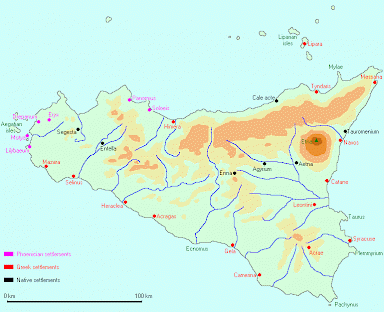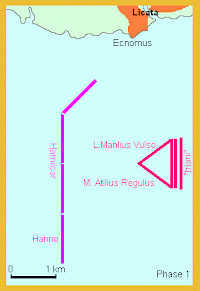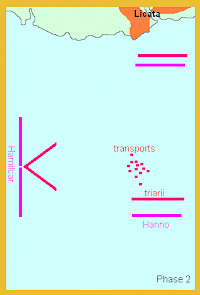Ecnomus (256 BCE)
Q6881Battle of Ecnomus (256 BCE): naval battle in the First Punic War, in which the navy of the unexperienced Romans unexpectedly defeated the well-trained navy of the Carthaginians. This was one of the largest battles in ancient history.

In 256, the Romans sent a fleet of no less than 330 ships from Sicily to Africa, where the army aboard was supposed to strike at the Carthaginian homeland. Before crossing the Mediterranean, it encountered a Carthaginian navy of 350 ships, not far from modern Licata, at Ecnomus, an early third-century city founded by refugees from Gela.
The fight at Ecnomus was to be one of the greatest battles in history, because both sides sent more than 140,000 men to the front. We can be confident about these figures because they are based on crew numbers. The Romans won the battle, and could continue to Africa, where they were eventually defeated.
The story is told by Polybius of Megalopolis in his World History,note which is offered here in the translation by W. R. Paton, and was taken from LacusCurtius.
Strategic Objectives
Both sides thought that they fought now on equal terms, and both threw themselves most thoroughly into the task of organizing naval forces and disputing the command of the sea, while in the meantime the land forces accomplished nothing worthy of mention, but spent their time in minor operations of no significance.
The Romans, therefore, after making preparations as I said, for the coming summer, set to sea with a fleet of 330 decked ships of war and put in to Messana. Starting again from there they sailed with Sicily on their right hand, and doubling Cape Pachynus they came round to Ecnomus, because their land forces too happened to be just in that neighborhood. The Carthaginians, setting sail with 350 decked vessels, touched at Lilybaeum,note and proceeding thence came to anchor off Heraclea Minoa.
The plan of the Romans was to sail to Africa and deflect the war to that country, so that the Carthaginians might find no longer Sicily but themselves and their own territory in danger. The Carthaginians were resolved on just the opposite course, for, aware as they were that Africa is easily accessible, and that all the people in the country would be easily subdued by anyone who had once invaded it, they were unable to allow this, and were anxious to run the risk of a sea-battle. The object of the one side being to prevent and that of the other to force a crossing, it was clear that their rival aims would result in the struggle which followed.
Tactical Preparations
The Romans had made suitable preparations for both contingencies - for an action at sea and for a landing in the enemy's country. ... The whole body embarked on the ships numbered about a 140,000, each ship holding 300 rowers and a 120 marines. The Carthaginians were chiefly or solely adapting their preparations to a maritime war, their numbers being, to reckon by the number of ships, actually above one 150,000. These are figures calculated to strike not only one present and with the forces under his eyes but even a hearer with amazement at the magnitude of the struggle and at that lavish outlay and vast power of the two states, if he estimates them from the number of men and ships.

The Romans, taking into consideration that the voyage was across the open sea and that the enemy were their superiors in speed, tried by every means to range their fleet in an order which would render it secure and difficult to attack. Accordingly, they stationed their two six-banked galleys, on which the consuls, Marcus Atilius Regulus and Lucius Manlius, were sailing, in front and side by side with each other. Behind each of these they placed ships in single file, the first squadron behind the one galley, the second behind the other, so arranging them that the distance between each pair of ships in the two squadrons grew ever greater. Having thus arranged the first and second squadrons in the form of a simple wedge, they stationed the third in a single line at the base, so that when these ships had taken their places the resulting form of the whole was a triangle. Behind these ships at the base they stationed the horse-transports, attaching them by towing-lines to the vessels of the third squadron. Finally, behind these they stationed the fourth squadron, known as triarii, making a single long line of ships so extended that the line overlapped that in front of it at each extremity. When all had been put together in the manner I have described, the whole arrangement had the form of a wedge, the apex of which was open, the base compact, and the whole effective and practical, while also difficult to break up.
About the same time the Carthaginian commanders briefly addressed their forces. They pointed out to them that in the event of victory in the battle they would be fighting afterwards for Sicily, but that if defeated they would have to fight for their own country and their homes, and bade them take this to heart and embark. When all readily did as they were ordered, as their general's words had made clear to them the issues at stake, they set to sea in a confident and menacing spirit. The commanders, when they saw the enemy's order, adapted their own to it. Three-quarters of their force they drew up in a single line, extending their right wing to the open sea for the purpose of encircling the enemy and with all their ships facing the Romans. The remaining quarter of their force formed the left wing of their whole line, and reached shoreward at angle with the rest.
Their right wing was under the command of the same Hanno who had been worsted in the engagement near Agrigentum. He had vessels for charging and also the swiftest quinqueremes for the outflanking movement. The left wing was in charge of Hamilcar, the one who commanded in the sea-battle at Tyndaris, and he, fighting as he was in the center of the line, used in the fray the following stratagem.
Battle

The battle was begun by the Romans who, noticing that the Carthaginian line was thin owing to its great extent, delivered an attack on the center. The Carthaginian center had received Hamilcar's orders to fall back at once with the view of breaking the order of the Romans, and, as they hastily retreated, the Romans pursued them vigorously. While the first and second squadrons thus pressed on the flying enemy, the third and fourth were separated from them, the third squadron towing the horse-transports, and the triarii remaining with them as a supporting force.

When the Carthaginians thought they had drawn off the first and second squadrons far enough from the others, they all, on receiving a signal from Hamilcar's ship, turned simultaneously and attacked their pursuers. The engagement that followed was a very hot one, the superior speed of the Carthaginians enabling them to move round the enemy's flank as well as to approach easily and retire rapidly, while the Romans, relying on their sheet strength when they closed with the enemy, grappling with the ravens every ship as soon as it approached, fighting also, as they were, under the very eyes of both the consuls, who were personally taking part in the combat, had no less high hopes of success. Such then was the state of the battle in this quarter.
At one and the same time Hanno with the right wing, which had held its distance in the first attack, sailed across the open sea and fell upon the ships of the triarii, causing them great embarrassment and distress. Meanwhile that part of the Carthaginian force which was posted near the shore, changing their former formation and deploying into line with their prows facing the enemy, attacked the vessels which were towing the horse-transports. Letting go their tow-lines this squadron met and engaged the enemy. Thus the whole conflict consisted of three parts, and three sea-battles were going on at a wide distance from each other.
As the respective forces were in each case of equal strength owing to their disposition at the outset, the battle also was fought on equal terms. However, in each case things fell out as one would expect, when the forces engaged are so equally matched. Those who had commenced the battle were the first to be separated, for Hamilcar's division was finally forced back and took to flight.

Lucius [Manlius] was now occupied in taking the prizes in tow, and Marcus [Atilius Regulus], observing the struggle in which the triarii and horse-transports were involved, hastened to their assistance with such of the ships of the second squadron as were undamaged. When he reached Hanno's division and came into conflict with it, the triarii at once took heart, though they had had much the worst of it, and recovered their fighting spirit.
The Carthaginians, attacked both in front and in the rear, were in difficulties, finding themselves surrounded, to their surprise, by the relieving force, and giving way, they began to retreat out to sea. Meanwhile both Lucius [Manlius], who was by this time sailing up and observed that the third squadron was shut in close to the shore by the Carthaginian left wing, and Marcus [Atilius Regulus], who had now left the horse-transports and triarii in safety, hastened together to the relief of this force which was in grave peril; for the state of matters now was just like a siege, and they all would evidently have been lost if the Carthaginians had not been afraid of the ravens and simply hedged them in and held them close to the land instead of charging, apprehensive as they were of coming to close quarters.
Aftermath
The consuls, coming up rapidly and surrounding the Carthaginians, captured 50 ships with their crews, a few managing to slip out along shore and escape. The separate encounters fell out as I have described, and the final result of the whole battle was in favor of the Romans. The latter lost 24 sail sunk and the Carthaginians more than 30. Not a single Roman ship with its crew fell into the enemy's hands, but 64 Carthaginian ships were so captured.
After this the Romans, laying in a further supply of provisions, repairing the captured ships, and bestowing on their men the attention which their success deserved, put to sea and sailed towards Africa.